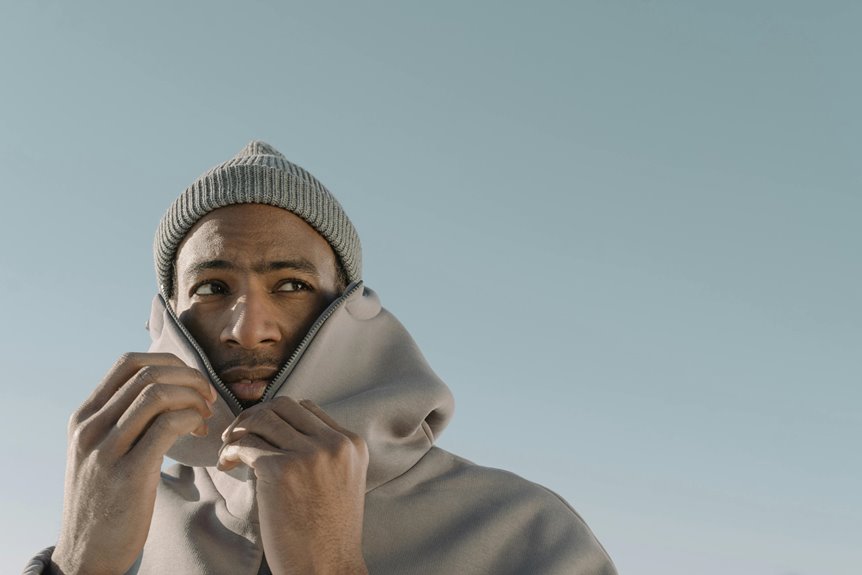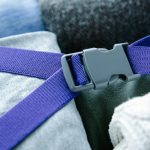You might not realize that hemp fabrics have been used for centuries in various cultures, yet they’ve gained renewed attention for modern outdoor gear. These materials can adapt remarkably to extreme weather conditions, offering benefits you might not expect. From insulation in the cold to breathability in the heat, hemp’s versatility is impressive. But how do these features stack up against other popular fabrics? Let’s explore the advantages and see if hemp could be your next go-to choice.
Table of Contents
Key Takeaways
- Hemp fabrics provide natural insulation and breathability, making them effective for both cold and hot weather conditions.
- Their moisture-wicking properties keep skin dry, enhancing comfort during physical activities in extreme weather.
- Hemp’s durability ensures long-lasting performance, reducing the need for frequent replacements in harsh environments.
- Unlike synthetic materials, hemp maintains a balance of warmth and ventilation, preventing discomfort from moisture retention.
- Hemp’s natural UV resistance protects skin from harmful rays, making it an ideal choice for outdoor adventures.
Advantages of Hemp Fabrics in Cold Weather
When you’re braving the chill of cold weather, you’ll find that hemp fabrics offer impressive advantages for keeping you warm and comfortable.
To start, hemp’s natural insulation properties trap heat effectively, providing you with a cozy layer against the cold. Unlike synthetic fabrics, hemp breathes well, allowing moisture to escape while retaining warmth, so you won’t feel clammy.
Hemp’s natural insulation traps heat while allowing moisture to escape, keeping you warm and comfortable without the clamminess of synthetic fabrics.
Additionally, hemp’s durability means your winter gear can withstand harsh conditions, making it a reliable choice for outdoor adventures. The fabric’s natural resistance to mold and mildew also guarantees you stay fresh, even in damp conditions.
Plus, hemp is eco-friendly, allowing you to stay warm while being kind to the planet. Embracing hemp fabrics makes winter weather more bearable, stylish, and sustainable.
Benefits of Hemp Fabrics in Hot Weather
When the heat kicks in, hemp fabrics can be your best friend.
They offer impressive cooling properties that help regulate your body temperature, keeping you comfortable in the sweltering sun.
Plus, their moisture-wicking advantages guarantee you stay dry, making hot weather a lot more bearable.
Cooling Properties Explained
Although summer heat can be relentless, hemp fabrics offer a natural solution for staying cool and comfortable.
These fabrics have unique properties that allow air to circulate, creating a cooling effect against your skin. When you wear hemp, you’ll notice its breathability; it helps regulate your body temperature, keeping you from feeling overheated.
The structure of hemp fibers allows for better ventilation compared to many synthetic materials, so you can wear it longer without discomfort.
Additionally, hemp’s natural UV resistance helps protect your skin from harmful rays while you enjoy the outdoors.
Moisture-Wicking Advantages
As temperatures rise, staying dry becomes essential, and hemp fabrics excel at moisture-wicking. When you wear hemp, it effectively pulls moisture away from your skin, allowing it to evaporate quickly. This helps you feel cooler and more comfortable, even in the hottest conditions.
Unlike synthetic fabrics, which can trap sweat, hemp allows for better airflow, keeping you dry and reducing that sticky feeling. Additionally, hemp’s natural properties help prevent odor, so you can stay fresh throughout your day.
Whether you’re hiking, working, or just enjoying the outdoors, choosing hemp clothing means you’re investing in a fabric that actively works to keep you comfortable. Embrace the moisture-wicking advantages of hemp and enjoy your time in the heat without worry.
Moisture and Water Resistance of Hemp
When you’re out in extreme weather, understanding how hemp handles moisture can make a big difference.
Hemp’s impressive moisture absorption capability means it keeps you dry by wicking away sweat, while its quick-drying properties help you stay comfortable in damp conditions.
Plus, hemp maintains its strength even when wet, ensuring your gear remains reliable no matter the weather.
Moisture Absorption Capability
Hemp fabrics excel in moisture absorption, making them an ideal choice for extreme weather clothing. When you’re out in unpredictable conditions, you want a fabric that can wick moisture away from your skin, keeping you comfortable.
Hemp does just that, drawing sweat away and allowing it to evaporate quickly. This natural fiber can absorb up to 30% of its weight in moisture without feeling wet, ensuring you stay dry even during intense physical activity.
Additionally, the breathable nature of hemp allows for airflow, which helps regulate your body temperature. Choosing hemp for your extreme weather gear means you’re investing in a fabric that not only manages moisture effectively but also enhances your overall comfort and performance in challenging conditions.
Quick Drying Properties
While you’re braving the elements, having clothing that dries quickly can make all the difference in your comfort and performance.
Hemp fabric excels in this area, thanks to its unique structure. It absorbs moisture without feeling heavy or soggy, allowing it to release water efficiently. When you’re caught in the rain or sweating during a hike, hemp’s quick drying properties keep you feeling lighter and more comfortable.
Unlike many synthetic fabrics, hemp doesn’t retain water, which means you won’t be left shivering in damp clothes. The breathable nature of hemp also encourages airflow, aiding in faster drying times.
Strength When Wet
Moisture doesn’t just affect how quickly your clothes dry—it also impacts their strength. When hemp fibers get wet, they actually maintain a significant amount of their tensile strength, unlike some other materials that weaken.
This resilience makes hemp a reliable choice for extreme weather conditions. Even when soaked, hemp can endure stress and strain, holding up against windy, rainy environments. You won’t have to worry about your gear falling apart when you need it most.
Additionally, hemp’s natural water resistance means it repels moisture to some extent, keeping you drier for longer. So, if you’re looking for durable clothing that can withstand the elements, hemp’s strength when wet is definitely a major advantage.
Durability and Sustainability of Hemp Fabrics
When considering fabrics for extreme weather clothing, durability and sustainability are essential factors that can’t be overlooked.
Hemp fabrics stand out in both areas. They’re naturally strong, resisting wear and tear even in harsh conditions. This means your clothing will last longer, reducing the need for frequent replacements.
Hemp fabrics are naturally strong, offering durability that reduces the need for frequent clothing replacements in harsh conditions.
Plus, hemp grows quickly and requires minimal water and pesticides, making it an eco-friendly choice. By opting for hemp, you’re supporting sustainable agriculture and reducing your carbon footprint.
You’ll appreciate the comfort and resilience of hemp while knowing you’re making a responsible decision for the planet.
In extreme weather, you want gear that performs well and lasts, and hemp fabrics deliver on both counts without compromising environmental integrity.
Features of Hemp for Outdoor Gear
Hemp’s unique properties make it an ideal choice for outdoor gear. Its natural breathability allows air to circulate, keeping you cool in warm conditions while providing insulation against the cold.
The fiber’s strength guarantees your gear can withstand the rigors of outdoor activities, resisting tearing and wear. Hemp also has a natural moisture-wicking ability, drawing sweat away from your skin to keep you dry during intense physical exertion.
Additionally, its UV resistance protects you from harmful sun rays, making it suitable for hiking, camping, or any outdoor adventure. Plus, hemp’s lightweight nature means you won’t be bogged down, allowing for greater mobility.
With all these features, hemp gear supports your outdoor lifestyle effectively and sustainably.
Health and Hygiene Benefits of Hemp Clothing
While you enjoy the outdoors, wearing hemp clothing can offer significant health and hygiene benefits.
Hemp fibers possess natural antimicrobial properties, which help keep bacteria and odors at bay, making your outdoor adventures more pleasant. Additionally, hemp is hypoallergenic, reducing the risk of skin irritation for those with sensitivities. Its breathability allows for better air circulation, keeping you cool and comfortable.
- Natural antimicrobial properties to combat odors
- Hypoallergenic, minimizing skin irritation
- Breathable fabric promoting air circulation
Comparisons With Other Fabrics for Extreme Weather
Although many fabrics claim to be suitable for extreme weather conditions, hemp stands out for its unique combination of durability, breathability, and moisture-wicking properties.
Compared to cotton, hemp outperforms in strength and dries faster, making it a better choice for unpredictable weather.
While synthetic materials like polyester offer water resistance, they often trap heat and moisture, leading to discomfort.
Wool, known for its insulation, can retain moisture, which isn’t ideal in wet conditions.
Hemp, on the other hand, effectively balances warmth and ventilation, keeping you comfortable.
Hemp fabrics strike the perfect balance between warmth and ventilation, ensuring your comfort in any weather.
When you’re facing extreme weather, you want a fabric that not only protects but also allows your skin to breathe.
Hemp fabrics deliver that balance, making them a smart choice for your outdoor adventures.
Frequently Asked Questions
How Does Hemp Impact the Environment Compared to Synthetic Fabrics?
Hemp considerably reduces environmental impact compared to synthetic fabrics. You’ll find it requires less water, avoids harmful chemicals, and promotes soil health, making it a more sustainable choice for eco-conscious consumers like you.
Can Hemp Fabrics Be Blended With Other Materials?
Yes, you can blend hemp fabrics with other materials like cotton or recycled polyester. This combination enhances durability, comfort, and versatility, allowing you to enjoy the benefits of hemp while achieving desired qualities in your clothing.
What Are the Care Instructions for Hemp Clothing?
Imagine your favorite shirt, soft and durable. To care for hemp clothing, wash it in cold water, avoid bleach, and tumble dry on low. Iron it on low heat if needed, keeping it looking fresh.
Are There Any Downsides to Wearing Hemp Fabrics?
While hemp fabrics are durable and eco-friendly, they can sometimes be coarse, leading to discomfort for some. They may also wrinkle easily and require specific care to maintain their quality over time.
How Does the Cost of Hemp Clothing Compare to Other Fabrics?
When you’re comparing costs, hemp clothing often falls in the mid-range. While it might be pricier than cotton, it can be cheaper than some high-performance synthetics, offering durability and sustainability that justify the investment.
- Does Chiffon Fabric Stink - July 15, 2025
- Does Chiffon Fabric Affect the Economy - July 15, 2025
- Does Cotton Fabric Have a Nap - July 15, 2025



